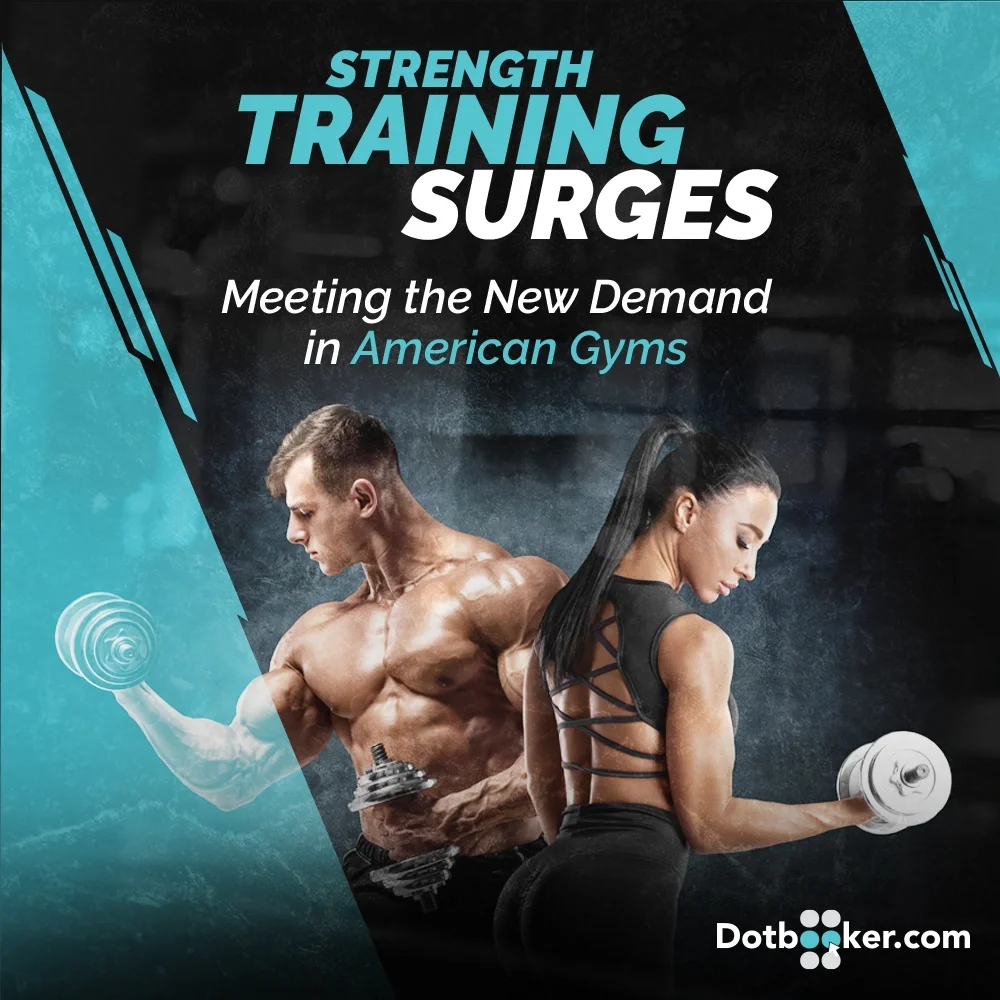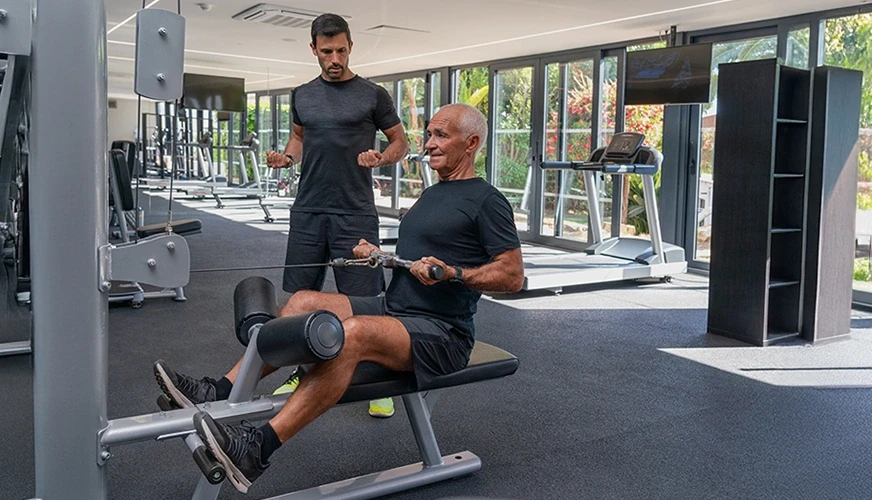
- By Dotbooker
- Apr 16, 2025
- 1181
Strength Training Surges: Meeting the New Demand in American Gyms
Once upon a treadmill, cardio was king.
Gyms were filled with the rhythmic thump of sneakers on rubber belts, and rows of elliptical machines held sway like royal courtiers. Strength training? That was the side quest. An afterthought. A corner niche for bodybuilders, powerlifters, and those who dared to wander into the clang and clatter of iron.
Fast forward to 2025: the tides have turned. The strength training trends in the USA have gone from underground to unavoidable, and American gyms are being reshaped by them, both literally and culturally.
This isn’t just a new chapter in fitness — it’s a genre shift.
Mindset Shift: Why Strength Is Now the Goal, Not the Bonus
There was a time when people would walk into a gym and say, “I just want to lose a few pounds.” That narrative is evolving. More and more, people now walk in saying, “I want to get strong.”
It’s not vanity driving this. It’s science, lifestyle, and something even deeper — a shift in what we value about our bodies.
Here’s why:
- Metabolic health research has shown that lean muscle is a key component in regulating insulin, promoting fat oxidation, and enhancing longevity.
- Mental health studies connect resistance training to reduced anxiety, improved cognitive performance, and emotional resilience.
- And perhaps most telling: strength = independence, especially in aging populations. Being able to carry your groceries or stand from a chair without help isn’t just fitness. It’s freedom.
These shifts are echoed across demographics. Teens are leaving earlier. Women are dominating squat racks. Seniors are embracing kettlebells. Even corporate wellness programs are swapping “10k steps a day” for “three full-body lifts a week.”
In 2025, strength training in the United States is no longer a niche — it’s a necessity.
Strength Is Social: How Online Culture Changed the Gym Floor
We can’t discuss this revolution without acknowledging its origins: social media.
Scroll through Instagram or TikTok, and it’s not just influencers doing deadlifts in slow motion. It’s real people logging their PRs, celebrating their strength gains, and building entire communities around barbell culture.
And these aren’t just aesthetics-driven videos. They’re educational, inclusive, and empowering.
- A mother of two breaking a squat plateau at 40
- A teenager learning deadlift form from online coaches
- A 60-year-old showcasing their TRX pull progression
Strength training has become a shared language, and social media has made gyms feel less intimidating, making them more like arenas of personal transformation.
What does that mean for gym owners?
It means your lifters are no longer quiet solo warriors. They’re your loudest marketers — filming form checks, tagging your location, reviewing your equipment. Ignore their needs, and you miss not only retention but viral reach.

Strength Myths You Should Stop Believing (Right Now)
For every person embracing iron, there’s another hesitating because of outdated, misinformed, or downright ridiculous myths. And these myths aren’t just harmless — they’re barriers to progress, confidence, and gym membership engagement.
Let’s break some of the most persistent myths down — with clarity, facts, and a touch of real talk.
Lifting makes you bulky.
This myth has haunted gym floors, particularly women’s locker rooms, for decades.

Here’s the truth: bulk doesn’t happen by accident. Building visibly large muscle mass takes years of heavy lifting, progressive overload, dedicated nutrition, and — in many cases — a genetic predisposition toward hypertrophy.
What strength training does for most people:
- Tones and defines muscles
- Increases fat loss by improving metabolism
- Boosts posture, mobility, and functional movement
If someone gains a few inches on their legs or arms from lifting, it’s not “bulking up.” It builds strength and lean mass, which improves shape and increases fat-burning potential even while at rest.
Machines are for beginners, free weights for pros.
Let’s put an end to elitism once and for all.
While free weights offer greater freedom of movement and demand stabilizer activation, machines have a strategic place in any well-rounded program, suitable for all levels.

Machines are:
- Excellent for isolating muscles (e.g., leg extensions, cable rows)
- Safer for training to failure without a spotter
- Ideal for injury rehab or low-risk movement
- Useful when gym floors are crowded and time is tight
Even elite athletes incorporate machines into their routines—or use them for accessory work, rehab, or deload weeks. So why should beginners feel any shame in using them?
You need to be young to lift heavy.
This myth isn’t just wrong — it’s dangerous.
In truth, strength training becomes increasingly important as we age, not less so. After the age of 30, we start losing 3–8% of our muscle mass per decade. By the time we hit 60? That accelerates, unless we intervene.

Regular resistance training in older adults:
- Preserves bone density, reducing fracture risk
- Improves balance and stability, lowering fall risk
- Enhances cognitive function, mood, and quality of life
One of the most powerful transformations? A 68-year-old gym member who, after 6 months of progressive strength work, no longer needed a cane.
Use This to Educate and Engage
These myths are teachable moments, not just filler for a blog. Use them to power:
- Short-form social media reels
- Onboarding education slides for new members
- Myth-busting gym posters around your free weight area
- Staff-led mini-workshops like “Lifting Myths Debunked: What Science Actually Says”
Because here’s the secret: strength education drives strength retention. The more people understand, the more they lift — and the longer they stay with you.
Outdated Equipment is a Dealbreaker — Not a Quirk
Remember when rusty dumbbells and clunky cable machines were considered charmingly “old school”? Not anymore.
The modern fitness consumer sees equipment as an experience. They want function, form, and feedback — all in one.
Here’s where gym equipment upgrades become mission-critical:
- Adjustable smart machines that auto-calibrate weight based on fatigue or range of motion
- Integrated rep counters with tempo tracking and progress analytics
- Free weight stations with ergonomic grips, vertical storage, and seamless switching
- Functional training zones with modular rigs, sled tracks, and open turf for movement drills
These upgrades aren’t just cosmetic. They’re strategic retention tools. Lifters stay where their progress is supported — and where their form doesn’t suffer because a pulley jerks mid-rep.
Investing in equipment is no longer just about maintaining appearances; it's also about enhancing productivity. It’s about keeping members — period.

Programming That Meets the Modern Muscle Mindset
Offering a one-size-fits-all “strength class” twice a week? That’s cute — but it’s not 2025-ready.
Today’s lifters demand structure. Personalization. Progressive programs that understand muscle adaptation and recovery, not just movement.
The best gyms now offer:
- Microcycle and mesocycle planning for every skill level
- Beginner lifter onboarding programs that include form workshops and mobility screening
- Women-specific hypertrophy classes, understanding hormonal phases, and lifting periodization
- Muscle-building programs that track progressive overload with tech-based insights
- Advanced Olympic lifting tracks with scheduled deload weeks and technique clinics
And let’s not forget nutrition and supplementation support, because lifting without the right fuel is like trying to grow a tree in dry soil.
The bar has been raised. Your members want to train, not just work out.
Strength Has Gone Mainstream — And the World Is Watching
This isn’t a fitness industry echo chamber. Strength has gone mainstream in policy.
- Schools are overhauling physical education to include structured resistance training.
- Insurance companies are exploring the option of offering lower premiums to members who participate in certified lifting programs.
- Doctors are prescribing strength routines alongside medications for diabetes, osteoporosis, and postnatal care.
In this new ecosystem, strength isn’t an option. It’s operationalized wellness. It’s cultural. It’s medical. It’s social.
If you’re running a gym or studio, you’re not just offering workouts; you're also providing a community. You’re providing one of the most effective health interventions available — and the infrastructure to support it needs to reflect that.
So What Now? Strength Needs a System
As the iron era intensifies, there’s a new kind of pressure on gym owners and managers: how to deliver all this, at scale, with simplicity.
From managing multi-coach strength programs to offering class credits, personal training schedules, flexible booking slots, and muscle-progress tracking — it’s a heavy lift.
That’s where Dotbooker comes in.
Dotbooker isn’t just a tool. It’s the operating system for modern strength-centric gyms. It lets you:
- Customize training plans and auto-assign them to members.
- Schedule strength cycles, deload weeks, and progression paths to optimize your training.
- Manage equipment reservations for peak hours.
- Offer hybrid class access — virtual, in-person, or recorded.
- Analyze member trends (and lifter loyalty) with dashboard reports.
And most importantly? It frees your staff from tedious administrative tasks, allowing them to focus on what matters — coaching strength, not managing spreadsheets.
Iron Will, Smarter Tools
In this era of strength training surges, gyms that don’t evolve will fade into the background of a fast-paced industry. But those that invest in smart programming, in modern gear, in digital solutions — will not only survive, they’ll lead.
Strength is no longer about lifting more. It’s about knowing more. Delivering more. Supporting more.
And with the right systems behind you — like Dotbooker — you can do all of that, and still leave time for a PR of your own.
Popular Blogs

- Oct 20, 2022
- 4716

- Sep 08, 2024
- 4032

- Nov 11, 2022
- 3472

- Sep 16, 2024
- 2848
Transform your business now!

Get an expert consultation for your business's streamlined operations.